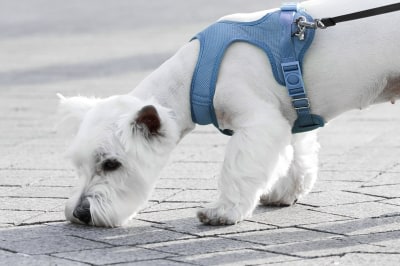Many dogs are natural swimmers, but some may need a little extra guidance when it comes to getting comfortable in the water. Today, our Oklahoma City vets will detail how to teach your dog to swim, focusing on positive reinforcement and patience to help build their confidence in the water.
Can all dogs swim?
While many dogs are capable swimmers, not all dogs have the natural ability to swim. Breeds such as Labrador Retrievers, Golden Retrievers, and Portuguese Water Dogs are known for their love of water and strong swimming abilities.
However, breeds with short legs, heavy bodies, or flat faces may struggle in the water and should be closely supervised if they are around bodies of water. It is important to consider a dog's individual characteristics and comfort level in the water before assuming they can swim proficiently.
How to Tell if Your Dog Wants to Be in the Water
There are several signs that can indicate whether your dog wants to be in the water. One common sign is if your dog eagerly approaches bodies of water or shows excitement when near water sources.
Another sign to look for is if your dog actively seeks out opportunities to cool off in the water on hot days. Some dogs may also exhibit behaviors such as pawing at the water, wagging their tail while in the water, or even attempting to jump into bodies of water on their own. Paying attention to your dog's body language and behavior can help you determine if they truly enjoy being in the water.
How to Teach Your Dog to Swim
If you've determined that your dog is a good fit for swimming, then go ahead and teach them. Start slow, and gradually build their confidence using positive reinforcement techniques. Below, we'll list some steps your can follow.
Start Small
Start by introducing your dog to shallow water, such as a kiddie pool or calm lake. Encourage them to enter the water with treats or toys, and praise them for their bravery. Gradually increase the depth of the water as they become more comfortable and confident in their swimming abilities.
Introduce the Doggy Paddle
Once your dog is comfortable in shallow water, introduce them to the doggy paddle technique. Show them how to move their legs and paddle with their front paws while keeping their head above water. Practice this in a safe and controlled environment until they become proficient swimmers. Remember to always supervise your dog while they are swimming to ensure their safety.
For added safety, you can also strap a lifejacket on them during this stage.
Keep on Practicing
Continue to gradually increase the length of swimming sessions for your dog, incorporating both familiar exercises and new challenges as they become more proficient in the water. Consider having them swim greater distances or engaging in fun activities like playing fetch in the pool to keep them motivated and excited.
Water Safety Tips for Dogs
Even if you successfully train your dog how to swim, there are still some safety considerations to keep in mind. These include:
- Never leaving your dog unattended in the water.
- Washing your dog after swimming with clean water to avoid irritation of their skin and coat.
- Always providing fresh water afterwards so they have a place to get a drink of salt or chemical-free water.
If your dog usually swims in a pool, you should:
- Keep the pool fenced or covered so your dog can’t wander in unsupervised.
- Make sure exits to the pool are always clear of any obstructions like pool floats.
- Make sure sure pool water has very low doses of chlorine.
Note: The advice provided in this post is intended for informational purposes and does not constitute medical advice regarding pets. For an accurate diagnosis of your pet's condition, please make an appointment with your vet.



